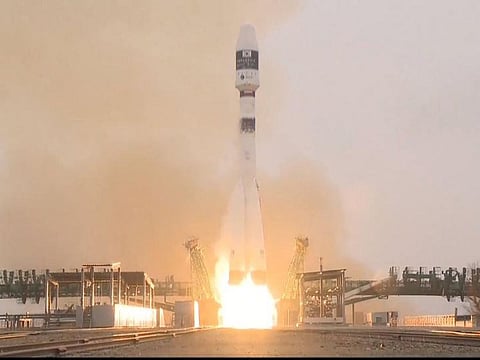Watch: Cheers on the ground as first signal arrives from Dubai Municipality’s DMSat-1
Signal received at 4:42pm UAE time, reveals Mohammed Bin Rashid Space Centre

Dubai: The first signal from DMSat-1, the emirate’s first nanometric environmental satellite -- developed by Dubai Municipality in collaboration with the Mohammed Bin Rashid Space Centre (MBRSC) -- was received on Monday evening.
“The first signal from the DMSat-1 has been received at 4:42 pm (UAE time),” MBRSC announced in a tweet. It confirmed that the satellite had reached its orbit and begun its scientific mission. A video shared by the space centre showed the satellite team members at MBRSC’s mission control centre cheering and clapping after the announcement of the reception of the signal.
The milestone achievement took place more than six-and-a-half-hours after the Russian-made Soyuz-2.1a rocket, that carried DMSat-1 and 37 other satellites from 17 other countries, took off to space from Baikonur Cosmodrome in Kazakhstan at 10.07am UAE time.
Monday’s launch comprised three stages including first and second stage separations of the satellites from the rocket and the third stage of main engine cutoff.
“The Fregat carrying the DMSat-1 satellite has separated from the Soyuz-2.1a rocket,” MBRSC tweeted at 10:18am.
The ascent was completed successfully; it was announced after the completion of the three stages.
Rocket payload
The Soyuz 2.1a rocket carries the main payload – a 500kg CAS500-1 remote sensing Earth observation satellite for the Korea Aerospace Research Institute (KARI), as well as smaller payloads for UK, Russia, Japan, Italy, Netherlands, Germany, Canada, Thailand, Spain, Slovakia, Argentina, Israel, Brazil, Hungary, Tunisia and Saudi Arabia.
The Russian-made launch rocket has been given a white and blue livery to mark 60 years since the launch of cosmonaut Yuri Gagarin, who became the first human to walk in space on April 12, 1961.
What DMSat-1 will do
According to Dubai Municipality, DMSat-1 is not only the region’s first low-orbit environmental satellite but is also the UAE’s contribution in combatting global climate change.
It will study the phenomenon of sandstorms in the UAE and the wider region and will also be used to detect greenhouse gases to support environmental research and climate change related studies.
DMSat-1, a collaboration between Dubai Municipality and MBRSC, was built by engineers at Space Flight Laboratory (SFL) at the University of Toronto. It will be the fourth satellite in orbit that will be operated by MBRSC, after DubaiSat 2, KhalifaSat and Hope Probe.
MBRSC will manage the gathering and delivery of data generated by the project for Dubai Municipality. The data will then be shared with academic institutions inside and outside the UAE as part of data-sharing with other countries, in compliance with the Paris Agreement.
Satellite specifications
DMSat-1, which weighs only 15kg and has a dimension of 20X30X40 cm with a solar panel spanning 50cm, is a high-performance nanosatellite designed to perform multi-spectral observations.
It has three scientific instruments, including multi-spectral polarimeter used to monitor air quality and detect fine particles in the atmosphere and a pair of spectrometers that will be used to detect greenhouse gases (carbon dioxide and methane).
The multispectral polarimeter, in particular, is a relatively new technology used by few space missions.
It is used for remote sensing to collect improved characterisation of atmospheric aerosol. DMSat-1’s polarimeter will monitor and measure air pollutant, develop an air quality map, study seasonal changes and levels of air pollutants, and study the sources of air pollutants.
Sign up for the Daily Briefing
Get the latest news and updates straight to your inbox









